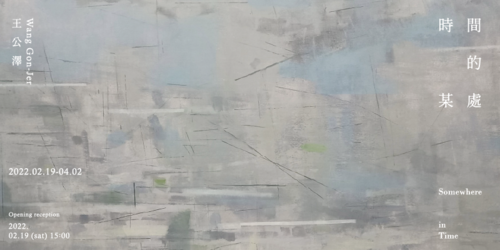Somewhere in Time – Wang Gon-Jer Solo Exhibition
Through perceptual aesthetic intuition, I repeatedly savor and explore geometric manmade spaces and infinite natural forms to discover their organic mixture, which not only transcends them both but also intricately connect them with each other in their mutual influences. Moving between accidental occurrences and meticulous designs, freehand and instrumental marks from the painting process are preserved and subsequently used for the connection and arrangement of space. —Wang Gon-Jer
Double Square Gallery is pleased to announce that Somewhere in Time – Wang Gon-Jer Solo Exhibition will soon open at the gallery on February 19 and run through April 2, 2022. This is the artist’s first solo exhibition at Double Square Gallery since his participation in the group exhibition, 2021 Lineage, staged last year. This solo exhibition showcases a total of sixteen paintings featuring spiritually poetic images delineated with a calm, reserved brush style in various shades of gray. Through the working of perception and intuition, the artist places an emphasis on the integration of light, temporality and spatiality while comparing his work to “a medium for recalling the past.” This is because the past we have lived, experienced, perceived and undergone have left imprints in our memories, which engender an inner resonance with the works in front of our eyes. Through Wang’s translation and careful selection, these profound memories consequently surface as objects to be gazed upon and recall the past.
The exhibition title, Somewhere in Time, originates from the expression of emotions from the artist himself: None of us can resist and stop the flow of time. Therefore, following the change of time, space and light, Wang first perceives and internalizes everyday sights before abstracize and visualize them in the imaginative space. His homonymous painting series, Somewhere in Time, is derived from a previous series but portrays fresh feelings with different methods and physical perceptions. These images are not only incorporated with elements of natural light and shadow, but also include geometric lines that convey a sense of artificiality. With these non-organic compositions, the artist means to deeply explore the coexistence between humankind and nature, the East and the West, as well as the past and the present. Wang Gon-Jer specializes in oil and charcoal painting. The modifiability and changeability of the latter remind him of different states in nature and echo the constant changing flow of life. Wang believes that “sensibility” comprising precious human perception is a way of perceiving the surrounding environment even though it cannot ever be verified. Consequently, with “the measuring of sensibility” as a starting point, the artist transforms everything he has perceived in this space-time into this body of works. Only through quiet contemplation and imagination, in which the vision and the mind engage in interaction, could effective appreciation of his paintings be achieved.
Born in 1971 in Taipei. In 2009 Wang Gon-Jer received his Ph.D. in Fine Art at Auckland University, New Zealand. He currently teaches at Tainan University of Technology. His works have been exhibited in various countries around the world such as, New Zealand, Japan, the USA, Taiwan, Canada, Italy, China, etc. Wang pursued deep and solid concrete forms and techniques in the early days of his artistic creative process. After being inspired by religious beliefs, he has turned to the pursuit of sublimating the external life experience into the inner spiritual feeling. Through his intuition, he combines the nature, spirituality, and emotion experienced in life into one, and precipitated it into the natural and profound vibe on the canvas. His sketches make use of charcoal to remove the image, and manage numerous lines of varying lengths with rhythmic and structural characteristics in the painting. These works of art combine the impressionistic brushwork of East Asian ink wash painting and the spirit of Western abstract painting, making the viewer feel like being in the vast universe and wandering in the macroscopic and organic aesthetic experience.
